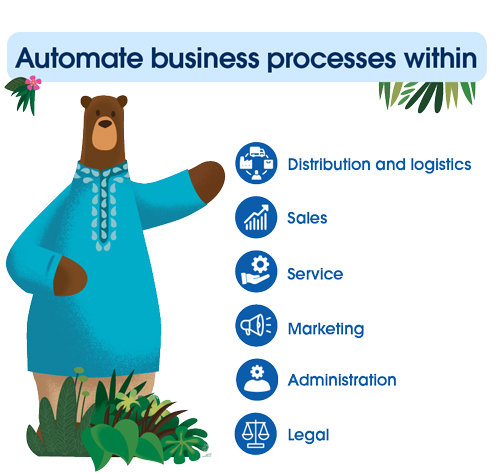Advantages of Automation: How Automating Business Processes can Help You



Wouldn’t it be great if most of the manual tasks in your business could be carried out automatically and without any trouble? It is possible now. Read about the advantages of automation and how they can help your business become more efficient and profitable.
Introduction to automation
Whether you are a start-up founder or a CIO at an MNC, it’s certain that your teams are spending more than a couple of hours each day on administrative tasks that are integral to your business. As important as these tasks are, they can be automated to save your employees’ time and utilise it better.
There are numerous advantages to automation in terms of the time saved and improved productivity. Automation is critical to managing, changing, and updating not only your IT infrastructure, but the way your business operates through its processes.
What is business process automation?
Business process automation (BPA) is simplifying and performing repetitive tasks without the need for human intervention. What this translates to is a highly motivated team that’s freed up for strategic and creative work, and businesses that are ready to scale up through error-free processes.
Businesses are adapting to disruption in various domains by automating processes across several core and support verticals, ranging from inventory management, payload and scheduling to employee management, customer engagement, sales, and marketing.
How does business process automation work?
Businesses often involve hundreds of tasks undertaken internally within teams and departments and through interactions with multiple external stakeholders. These engagements form a part of interconnected processes that are unique to a business and require checks at every stage to ensure adherence to accuracy, targets, and timelines.
Not only does an automation tool streamline all these tasks, but when it is connected with other tools, it can gather the right data needed to perform tasks correctly. It can also work seamlessly with your internal platforms and tools, often without any need for change in existing workflows or project execution plans that are underway.
What business processes can be automated?
The good news is that all the basic business processes that are well-defined and repeatable can be automated in principle. With advancements in automation tools, even those processes that require logical thinking and adaptability are automated using business intelligence, analytics, and decision support systems. This is one of the biggest advantages of automation today. 
Below are some examples of business processes that can be automated in:
Distribution: You can automatically create transportation routes, calculate order volumes, track and log the movement of goods, and do more.
Logistics: Automation tools can help with labelling and managing inventories, as well as setting up alerts on items that are running low.
Sales: Automation helps simplify sales teams’ efforts around lead management, tracking opportunities, prospect follow-ups, reporting, configuring, pricing, and quoting, etc.
Administration: Automation can streamline time-consuming processes like payroll creation and management, processing salaries and taxes.
Marketing: Automate your marketing campaigns, newsletter sends, social media posting and ad campaigns using marketing automation tools. Automation can help easily scale marketing campaigns and maximise their impact.
Customer service: Automation can enable service teams to consolidate service requests, feedback, common queries, etc. from different touchpoints onto a single platform. You can also automate customer engagement and case resolution through tools like chatbots and auto reply emails, among other things.
Legal: Automation tools can help secure legal agreements, deploy contract workflows, review thousands of documents with unstructured data, manage risk and compliance, etc.

Why is automation important?
While getting an order’s details wrong or entering incorrect data are problems that can be resolved, it takes up valuable time. Manual data collection can cost businesses a lot of time and money.
If used correctly, a well-designed automation tool can ensure that a business becomes more profitable for those running it and more convenient for those using its services. The automation of redundant tasks like data entry also ensures the accuracy of data.
At the end of the day, process automation enables organisations to do more in less time. By saving time on repetitive, manual tasks, teams can focus on more value-added work, like building customer relationships.
How to automate business tasks?
Identifying fundamental and repetitive tasks is a prerequisite to incorporating automation in your business process. For instance, recognising whether it is possible to create a work order automatically once a project has been confirmed.
It’s best to begin your automation journey with something small yet impactful. This helps you conserve resources while learning about which aspects of your business need to be automated. Carry those lessons forward, taking an incremental approach.
A highly evolved approach for automating business processes is to view functionalities via a “systems thinking” lens. Systems thinking looks at individual decisions and the consequences they have on the entire ecosystem of the business or organisation, internally and externally. For example, you can look at the current sales processes and suggest how automating the fulfillment or invoicing processes can impact your business.
This broader view allows CIOs and project managers to assess where automation should be deployed, what tools make the most sense for different activities, and what processes can be redesigned for simplicity.
How to choose the right task automation tool?
Business tasks can be automated using automation tools such as Approvals, Process Builder, Workflow, and Flow Builder. However, it is also essential that you understand the needs of your business first. This ensures that you choose the right automation tool by:
1. Outlining the processes that need automation
Once you outline the tasks and processes that need automation, the BPA tools can be customised to suit your business goals. Automation tools can be programmed for special use cases and there are also no-code tools that can be employed without disrupting productivity and project dynamics.
2. Doing your research
After identifying your business needs, you will know how and where automation will fit within your organisation’s workflow. For example, you are an eCommerce business selling merchandise via your online retail store and social media channels. If customer engagement and post-delivery servicing are your weakest links, CRM automation tools can help close the gaps by streamlining customer interaction without human intervention till it’s unavoidable.
3. Considering the tool’s scalability capabilities
Look for automation tools that can be scaled as your business grows. You can modernise new, more complex, and high-volume processes as your business evolves, enabling you to continuously deliver excellent customer experiences. For example, a popular tool in business process automation is Robotic Process Automation (RPA). It is configurable and further reduces human intervention and increases efficiency. An AI-based solution like Salesforce Einstein can help you automate time-consuming processes like data entry, processing documents, and follow up actions. Then, you can expand its use for any system or application without needing to code.
Want to create custom automated processes for your business?
Check out our suite of automation solutions for every function.



7 advantages of automation
Here are 7 advantages that business process automation lends to companies:
1. Maximises resources:
Automation helps maximise resource utilisation. For example, an automation tool set up to send alerts upon noticing that an item is running low in the inventory or delays in supply chain processes can save costs and prevent losses.
2. Frees up time:
Lost time amounts to losses in profit. Automation allows your employees to focus on high value work by taking care of repetitive processes. Automation tools can also help you execute tasks in much less time without exhaustion or boredom.
3. Eliminates errors:
Another major advantage of automation is that it reduces the scope for errors. For instance, an automation tool to ensure smooth workflows can detect missing documents in the system and prompt you to add them. Production line errors and legal compliances can also be taken care of by automation tools. This helps save time and cost.
4. Converts data into insights:
Automation helps a business convert data into actionable insight. Artificial intelligence (AI) can automatically gather and process data to extract actionable insights from it to help businesses make informed decisions. Insights can then be used in so many creative ways: to serve the customers better, to create strategies and predict metrics such as sales and costs, and to increase profits in a predictable manner.
5. Increases efficiency:
Automated processes are performed in a systematic manner, improving efficiency and standardising quality of work.
6. Enables better customer service:
In a world of always-on data, demand, and delivery, automation tools such as instant booking apps, chatbot, and feedback surveys at the end of a service or purchase makes all the difference between one-time sales and repeat interactions. Automation can help develop customer satisfaction in the long run.
7. Boosts scalability:
BPA can help an organisation achieve more with less. Profits are better, costs are reduced, employees are more efficient, and customers are happier. And all of this can be scaled as your business grows, a massive advantage of automation. 
How does business process automation software work?
BPA is available in different formats for a range of functionalities. While it is primarily a software application, it can also involve the use of robotics. These tools turn manual actions into workflows that require minimal to no human intervention.
Depending on your needs, you can get automation software for specific functions (like marketing) or a CRM with automation capabilities to streamline business processes across functions. Task automation tools offered by companies such as Salesforce do not even require coding. These tools are designed keeping business users in mind. But you can also use its pro-code tools for finer customisation.
Point-and-click features help automate tasks for consistency and timeliness. Ultimately, process automation enables organisations to do more with less in lesser time.
Automation in action: an example of the advantages of automation
Let’s take the example of an IT company that provides customised tech solutions across the logistics, transportation, and storage industries. If this company has to generate leads for acquiring new customers and target existing clients, this will involve a series of tasks around prospect data entry, data segmentation, prospect allocation, as well as a full range of marketing and social media campaigns.
Using traditional methods for following up with qualified leads, and monitoring ad campaign performance would involve many team members spending hundreds of hours poring over data and responding to sales queries from customers. As the business grows and the volume of inquiries increases, the response time will also increase.
This is where a marketing automation application can transform how your business captures, manages and nurtures leads, all the way to content management, CRM integration, analytics, and reporting.
Challenges of business process automation
Deploying a highly efficient business process automation tool does come with a set of challenges, chiefly the human resistance to change in the status quo. There are also concerns about job redundancies and lack of skilled resources who can adapt to the change.
Let’s take a look at 4 challenges businesses may face when opting for BPA:
1. Gauging the long-term impact of automation
When considering automation tools and proposals, ensure that whatever solution you employ has the flexibility to grow and adapt to future changes in your development process. On the other hand, before you begin fully automating your systems, assess whether your business can incur heavy capital outflows and disruptions in everyday processes in the short term.
Set automation targets for each department and assess whether software, AI, or technology platforms can optimise your delivery times, lead generation time or improve employee productivity.
2. Budget constraints
Businesses can go overboard with automation projects by aiming too high too soon and going over budget. Work with your CIO and senior leaders to set a vision of outcomes and measurable impacts of the automation process. Map a phase-wise delivery plan and work your way backwards to see how the implementation will cause short-term and long-term ripples.
3. Quality control after automation
Automation isn’t a magic bullet that will instantly make your processes foolproof. Like any other technology platform, it can have bugs and breakdowns. You must have a robust testing system to ensure your automation procedures meet high-quality control standards, similar to a roadmap for product development (test, deploy, assess, iterate, repeat). Once your automation project is deployed, monitor and measure its effectiveness to ensure it works as expected.
4. Employee onboarding while automation is in progress
As with any change in the workforce, the deployment of an updated technology brings with it resistance and confusion for employees. Conduct training sessions that help teams to understand the purpose of the BPA, its functionality, and how the workflow is going to change for the better for them.
CIOs and senior managers can also consider assigning a member from each function as a change ambassador. These POCs can help teams speed up adoption and allay concerns around becoming redundant.
Create an edge by leveraging the advantages of automation
To sum it up, the goal of any business or start-up should be to automate as many repetitive tasks as required, so that it allows your workforce to focus on strategic activities.
For customers, automation tools make interactions seamless, intuitive, and delightful. This increases customer satisfaction, leading to customer loyalty and developing a strong bond between customers and the company.
For business owners, automation tools provide smoother workflows and easier management of tasks. This reduces stress on employees, cuts procurement costs and intensive human resources capital, and helps the business to function smoothly.
All these advantages make automation one of the most important business tools that companies can adopt today.
Want to create custom automated processes for your business?
Check out our suite of automation solutions for every function.

























